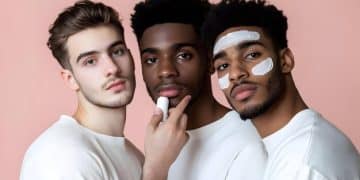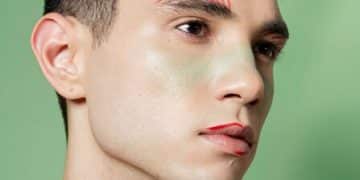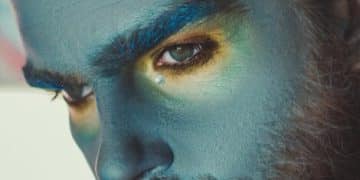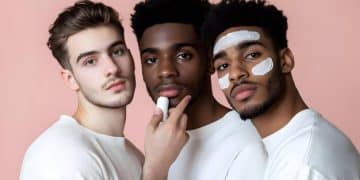Men’s Guide to Choosing Right Lipstick Shade for Your Skin Tone
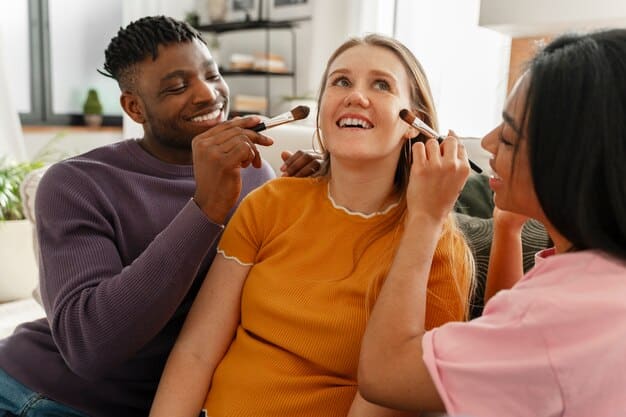
Mastering the art of choosing the right lipstick shade for your skin tone as a man involves understanding undertones, experimenting with different finishes, and embracing personal expression to enhance your look with confidence and style.
The evolving landscape of men’s style has seen a remarkable shift, with boundaries blurring and personal expression taking center stage. One area experiencing a significant transformation is the embrace of cosmetics, particularly lipstick. For men looking to explore this avenue, understanding how to choose the right lipstick shade for Your skin tone: a men’s guide is crucial. It’s not just about applying color; it’s about finding harmony with your natural features and projecting an image that feels authentic and powerful.
The Foundations: Understanding Your Skin Tone and Undertone
Beginning the journey into lipstick requires a foundational understanding of your own skin. It’s not enough to simply categorize yourself as “light” or “dark”; the nuances lie in your skin’s undertone. This subtle hue beneath the surface of your skin plays a pivotal role in how colors appear on you, dictating whether a shade will brighten your complexion or clash with it. Identifying your undertone is the first, most critical step.
The three primary undertones are warm, cool, and neutral. Many people mistakenly believe their surface skin tone is their undertone, but this is a common misconception. For example, someone with very fair skin can have a warm undertone, just as someone with deep skin can have a cool undertone. The trick is to look beyond the surface.
Identifying Your Undertone: The Vein Test
One of the most popular and reliable methods for determining your undertone is the vein test. Look at the veins on the inside of your wrist in natural light. This area of the skin is typically thin enough to allow your true undertone to show through without being distorted by surface redness or tan.
- Blue or Purple Veins: If your veins appear predominantly blue or purple, you likely have a cool undertone. This means your skin has pink, red, or bluish undertones.
- Green Veins: If your veins appear more green, you likely have a warm undertone. This indicates your skin has golden, peachy, or yellow undertones.
- Mixed/Indistinguishable Veins: If you can’t quite tell if your veins are blue or green, or if they seem to be a mix of both, you probably have a neutral undertone. This means your skin has a balanced mix of warm and cool undertones.
The Jewelry Test and Sun Exposure
Another helpful method is the jewelry test. Consider which type of metal complements your skin best. If sterling silver and platinum flatter your skin more, you likely have a cool undertone. If gold jewelry enhances your complexion, a warm undertone is probable. If both silver and gold look good, you might be neutral.
How your skin reacts to sun exposure can also offer clues. If you tend to burn easily and then tan faintly, you might have a cool undertone. If you tan easily and rarely burn, a warm undertone is more likely. Neutral undertones might experience a mix of both, sometimes burning but mostly tanning.
By accurately identifying your undertone, you begin to narrow down the vast array of lipstick shades, ensuring that your choices will harmonize with your natural coloring, creating a more cohesive and flattering look.
Shade Selection: Matching Lipstick to Your Undertone
Once you’ve confidently determined your skin’s undertone, the exciting process of selecting lipstick shades truly begins. The goal is to pick colors that enhance, rather than compete with, your natural complexion. Think of it as finding the perfect harmony, where the lipstick doesn’t just sit on your lips but becomes an extension of your natural vibrancy.
Lipstick Shades for Cool Undertones
Men with cool undertones typically look best in shades that have blue or purple bases. These colors will complement the pink or red tones in their skin, preventing the lipstick from looking too orange or brassy. Opt for colors that echo the coolness of your complexion.
- Berries and Plums: Deep berry shades, rich plums, and even some true reds with a blue base can be incredibly striking. Think of rich wine colors or deep fuchsia. These add a sophisticated depth.
- Pinks with Blue Hues: Dusty roses, mauves, and soft pinks with a hint of blue or purple work beautifully for a more subtle look. They provide a natural flush without overpowering.
- Cool Nudes: For a more understated option, look for nude shades with hints of beige, gray, or soft pink. Avoid nudes that lean too yellow or orange, as they can wash you out.
Lipstick Shades for Warm Undertones
For men with warm undertones, shades with orange, red, or gold bases will be the most flattering. These colors will enhance the golden or peachy tones in your skin, making your complexion appear more radiant and alive. Embrace the warmth!
- Corals and Terracottas: Vibrant coral, peachy-nudes, and earthy terracotta shades can truly pop against warm skin. They bring out a healthy glow and a touch of playful warmth.
- Reds with Orange or Brown Bases: Classic reds with an orange undertone, brick reds, or even deeper auburn shades will look incredibly rich. These provide warmth and an inviting allure.
- Warm Nudes: Nude lipsticks with hints of peach, caramel, or subtle yellow will blend seamlessly with warm skin. They offer a refined, natural finish that enhances without shouting.
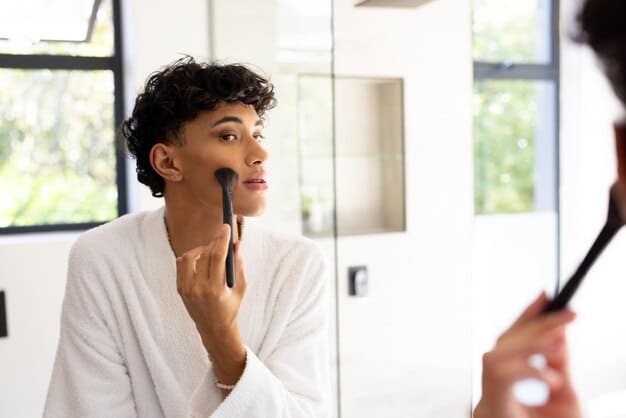
Lipstick Shades for Neutral Undertones
Men with neutral undertones are the most versatile, as they can pull off both warm and cool shades. The key is to choose shades that are balanced, without being too extreme in either direction. This flexibility allows for a wider range of experimentation.
- True Reds: A true red, which has an even balance of blue and orange undertones, will look stunning on neutral skin. It’s a classic, universally flattering choice.
- Mid-tone Pinks and Browns: Mauve-pink, rose, or medium brown shades work beautifully. They offer a natural enhancement that can be dressed up or down.
- Versatile Nudes: Most nude shades, from peachy-beiges to soft mauves, will complement neutral skin tones. Experiment to find which specific nude feels most comfortable and reflective of your style.
Experimentation is key, but using your undertone as a guide provides an excellent starting point, saving you time and helping you build a curated collection of shades that truly elevate your look and personal style.
Considering Skin Tone Depth: Light, Medium, and Dark Complexions
Beyond the undertone, the depth of your skin tone – whether light, medium, or dark – also significantly impacts which lipstick shades will be most flattering. A color that looks vibrant on fair skin might disappear on deeper skin, and vice versa. It’s about finding the balance between luminosity and intensity to ensure the lipstick complements your complexion without overwhelming it or getting lost.
Lipstick for Light Skin Tones
For men with lighter skin tones, subtle and soft shades often work best, providing a delicate flush of color without looking too harsh. The goal is to enhance your natural paleness, not to create a stark contrast. Lighter skin can easily be overwhelmed by overly dark or bright shades, which might appear bolder than intended.
- Soft Pinks and Peaches: These shades can add a healthy warmth and natural-looking flush. Think of a ‘your lips but better’ approach.
- Light Neutrals and Nudes: For a barely-there look, consider nudes that have a slight pink or peach tint. Avoid nudes that are too similar to your skin tone, as they can wash out your features.
- Sheer Berries: If you want a touch more color, very sheer berry or light plum stains can provide depth without heavy pigment.
Lipstick for Medium Skin Tones
Medium skin tones offer a broad canvas for experimentation, as they can carry a wider range of colors with ease. You can often transition between softer, natural shades and bolder, more saturated options, making this complexion depth particularly versatile. It’s about exploring different levels of intensity.
- Roses and Mauves: These are universally flattering for medium skin, offering a sophisticated and natural appearance.
- Rich Berries and Deep Reds: Medium skin can beautifully carry deeper shades like brick red, cranberry, and true berry tones. These provide a striking contrast and sophisticated edge.
- Caramels and Terracottas: Warm, earthy tones like caramel browns or terracotta oranges can enhance the skin’s subtle golden undertones.
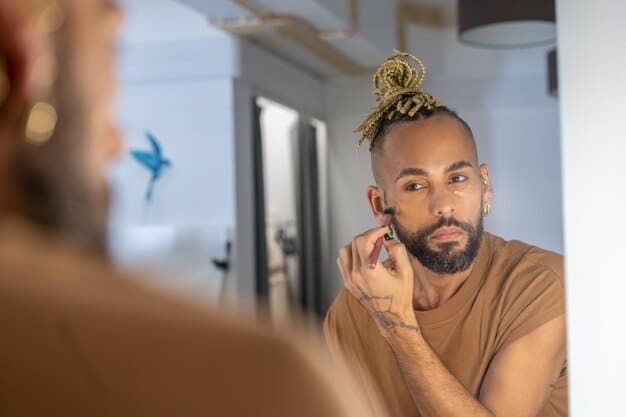
Lipstick for Dark Skin Tones
Darker skin tones beautifully accommodate rich, vibrant, and deep colors that might appear too intense on lighter complexions. These shades can truly come alive, providing striking contrast and enhancing the depth of the skin. The key is to select colors with substantial pigment that don’t get lost against the natural richness of the lips.
- Deep Reds and Wines: Bold oxblood, deep burgundy, and rich wine reds look incredibly luxurious and sophisticated.
- Vibrant Berries and Plums: Deep purple, true berry, and dark plum shades provide a dramatic yet harmonious effect.
- Rich Browns and Chocolates: Warm, deep brown shades, including chocolate and espresso, can be incredibly chic and flattering, offering a natural yet elevated look.
- Unexpected Brights: Don’t shy away from vibrant oranges, fuchsias, or even certain blues for a truly bold and artistic statement. These shades will pop with intensity.
When selecting shades based on depth, always consider the balance. Lighter complexions benefit from subtle enhancements, while deeper tones can embrace bold, rich pigments. The goal is to find shades that illuminate your features, creating a cohesive and flattering aesthetic that speaks to your unique style.
Exploring Finishes: Matte, Satin, Gloss, and Beyond
Beyond color, the finish of a lipstick significantly impacts its overall look and feel. From dramatic matte to subtle gloss, each finish offers a distinct aesthetic and texture. Understanding these differences is crucial for selecting the right lipstick that complements your desired look, whether it’s for a casual day out or a formal evening event. The finish can entirely transform how a shade appears on your lips.
Matte Finish
Matte lipsticks are known for their intense color payoff and velvety, non-shiny appearance. They offer a sophisticated and long-lasting look, making them ideal for impactful statements. Matte formulas tend to be less hydrating, so preparing your lips is essential.
- Pros: Excellent color saturation, long-wearing, modern and bold look. Creates a crisp, defined lip line.
- Cons: Can be drying, may emphasize lip lines or texture if lips aren’t prepped. Less forgiving for chapped lips.
- Best For: High-impact looks, formal events, when you need maximum longevity.
Satin and Cream Finishes
Satin and cream lipsticks strike a balance between matte and glossy. They offer good color payoff with a subtle sheen, mimicking the natural luminosity of healthy lips. These formulas often include moisturizing ingredients, making them more comfortable for extended wear.
- Pros: More comfortable and hydrating than mattes, natural-looking luminosity, versatile for various occasions.
- Cons: Less wear time than mattes, may transfer more easily.
- Best For: Everyday wear, professional settings, when you want both color and comfort.
Gloss and Sheer Finishes
Glossy lipsticks provide a high-shine, often transparent or semi-transparent finish. They add volume and a fresh, dewy look to the lips. Sheer lipsticks offer a hint of color with a natural, often glossy, finish. These are excellent for a subtle tint or creating a plumping effect.
- Pros: Hydrating, plumping effect, natural and youthful appearance, easy to apply.
- Cons: Short wear time, prone to stickiness, transfers easily, less color impact.
- Best For: Casual wear, adding a subtle touch of color, enhancing natural lip shape.
Metallic and Shimmer Finishes
Metallic and shimmer lipsticks incorporate fine glitter or pearlescent particles to create a reflective, luminous effect. They add a unique dimension and can be a bold fashion statement, catching the light and drawing attention to the lips. These are less about natural enhancement and more about artistic expression.
- Pros: Eye-catching, unique, adds texture and dimension. Can be very impactful for specific looks.
- Cons: Can emphasize lip texture, may not be suitable for all occasions, can feel gritty.
- Best For: Creative looks, special events, making a fashion statement.
Choosing the right finish is as personal as choosing the shade itself. Consider the occasion, your comfort level, and the overall aesthetic you want to achieve. Experimenting with different finishes can open up new possibilities for self-expression, allowing you to tailor your look to any mood or event.
Application Techniques and Confidence: More Than Just Color
Applying lipstick isn’t merely about swiping color onto your lips; it’s an art that involves technique, intention, and, most importantly, confidence. The way you apply lipstick can significantly alter its appearance and how comfortable you feel wearing it. For men, mastering these techniques enhances the overall effect, ensuring that the chosen shade truly complements your style journey.
Lip Preparation: The Crucial First Step
Regardless of the finish or shade, proper lip preparation is non-negotiable. Healthy, hydrated lips ensure smoother application and a more flattering result. Neglecting this step can lead to patchy application and highlights dry areas, detracting from the overall look.
- Exfoliate: Gently exfoliate your lips to remove any dry, flaky skin. You can use a dedicated lip scrub or a soft toothbrush with a little warm water. This creates a smooth canvas.
- Hydrate: Apply a hydrating lip balm a few minutes before lipstick application. Allow it to sink in fully, then blot away any excess before applying color. This step plumps and smoothes the lips.
Application Methods: From Bold to Subtle
The method of application can vary depending on the desired intensity and the lipstick’s finish. There’s no one-size-fits-all approach; versatility is key.
- Direct Application: For full opacity and intense color, apply lipstick directly from the tube or bullet. Start from the center of your top lip and work outwards, then repeat on the bottom lip. This method delivers maximum pigment.
- Lip Brush: For precision and an even application, especially with darker or matte shades, use a lip brush. This allows for controlled layering and crisper lines, which is excellent for definition.
- Finger Dab: For a soft, stained effect, dab the lipstick onto your lips with your fingertip. This creates a more diffused, natural finish, perfect for a subtle tint.
Defining and Shaping: The Lip Liner Option
Lip liner is an optional but powerful tool for enhancing definition, preventing bleeding, and extending wear time. While some men might skip this step for a more natural look, it’s invaluable for bold or dark shades.
- Choose a Match: Select a lip liner that matches your chosen lipstick shade or is one shade darker than your natural lip color.
- Outline and Fill: Outline your lips just outside your natural lip line for a fuller appearance, or directly on the line for definition. You can also lightly fill in your entire lip with the liner for a base that helps the lipstick last longer.
Embracing Confidence: The Ultimate Accessory
Beyond technique, the most significant factor in wearing lipstick well is confidence. Lipstick is a form of self-expression, and owning your choice is paramount. The way you carry yourself will determine how others perceive your bold move. If you wear it with assurance, it becomes a natural extension of your personal style.
Experimentation is a journey, not a destination. Don’t be afraid to try different shades, textures, and application methods to discover what makes you feel your best. The “right” lipstick shade is ultimately the one that makes you feel good, empowered, and authentically you. Embrace the process, have fun with it, and let your confidence shine through.
Matching Lipstick to Occasion and Personal Style
Choosing a lipstick shade is not just about complementing your skin tone; it’s also about aligning with the occasion, your outfit, and your overall personal style. Just as you wouldn’t wear a tuxedo to a casual brunch, certain lipstick shades and finishes are more appropriate for specific settings. This strategic alignment ensures your look is cohesive, impactful, and truly reflects your personality.
Casual Everyday Looks: Subtle and Natural
For daily wear, the focus is typically on comfort and a more understated appearance. You want something that enhances your natural lip color without being overly distracting. Sheer formulas, tinted balms, or subtle nude and rose shades are ideal.
- Tinted Lip Balms: Offer hydration with a hint of color, perfect for a laid-back look.
- Soft Nudes or Browns: Choose shades that are slightly deeper or brighter than your natural lip color to add definition without being too bold.
- Sheer Berries or Mauves: These provide a healthy flush that looks effortless and modern.
The goal is to maintain an approachable aesthetic, where the lipstick complements your features rather than dominating them. Think of it as an easy, low-maintenance enhancement.
Professional Settings: Polished and Refined
In professional environments, a polished and sophisticated look is paramount. The lipstick should exude confidence and professionalism without being overly distracting or informal. A clean, defined lip line and a long-wearing formula are often preferred.
- Satin or Cream Finishes: These offer a sophisticated sheen without being too shiny or distracting.
- Neutral Reds: A classic, muted red with a balanced undertone can be incredibly powerful and professional.
- Deep Plums or Berries: For deeper skin tones, a rich, well-defined plum or berry can convey authority and elegance.
- Understated Browns: A refined brown shade can offer a chic, modern, and professional aesthetic, especially in matte or satin finishes.
Avoid overly glossy or neon shades, which might be perceived as less formal. The key is to select shades that contribute to an image of competence and refinement.
Formal Events and Evening Wear: Bold and Dramatic
Formal events, parties, or evening outings are ideal opportunities to embrace bolder, more dramatic lipstick shades and finishes. This is where you can experiment with intense colors, metallic effects, and full-coverage mattes to make a memorable statement.
- Vibrant Reds: A true, bright red or a deep, vampy red can be incredibly striking and elegant.
- Deep Berries and Wines: Rich burgundy, oxblood, or deep plum shades create a sophisticated, dramatic effect.
- Metallic or Shimmer: For an edgy, fashion-forward look, consider metallic finishes that catch the light and add an intriguing dimension.
Ensure the lipstick is long-wearing and comfortable, as you’ll likely be talking, eating, and drinking. A bolder lip often pairs well with more minimalist eye makeup to keep the focus on your statement lips.
Your personal style should always be the guiding principle. If you’re someone who loves subtle details, lean into softer shades. If you’re drawn to bold statements, don’t shy away from vibrant colors. The most important thing is that your lipstick choice feels authentic to you and enhances the message you wish to convey.
Maintenance and Longevity: Keeping Your Lipstick Looking Its Best
Once you’ve found the perfect shade and applied it flawlessly, the next challenge is ensuring it stays put throughout the day or evening. Lipstick longevity is influenced by several factors, including the formula, your habits, and specific maintenance techniques. For men embracing lipstick, understanding these nuances means your chosen color will continue to complement your look without constant touch-ups or fading.
Prepping for Longevity
The foundation of long-lasting lipstick begins before application. Just like painting a wall, proper preparation ensures a smoother, more durable finish. Skipping these steps often leads to premature fading and uneven wear.
- Exfoliate and Hydrate: As mentioned, smooth, hydrated lips are less prone to flaking and help color adhere better. A good lip balm applied a few minutes prior and then blotted off creates an ideal surface.
- Lip Primer: A dedicated lip primer can create a smooth base, fill in lines, and help the lipstick grip the lips more effectively. Some primers also prevent feathering and bleeding.
- Concealer or Foundation Base: Lightly dabbing a thin layer of concealer or foundation onto your lips before applying lipstick can neutralize your natural lip color, making the applied shade appear truer, and provides an additional gripping surface for the lipstick, enhancing its wear time.
Application Techniques for Extended Wear
How you apply your lipstick can significantly impact its staying power. Small adjustments in technique can make a big difference in how long your color lasts without smudging or fading.
- Lip Liner as a Base: Instead of just outlining, fill in your entire lip with lip liner. This creates a robust base layer of color that acts as an anchor for your lipstick. Even if the top layer wears off, you’ll still have a tint underneath.
- Layering: Apply a thin layer of lipstick, blot with a tissue, dust lightly with translucent powder (a setting powder can work wonders), and then apply a second layer of lipstick. This technique “sets” the color and significantly increases its wear time.
- Blotting: After initial application, gently blot your lips with a tissue. This removes excess product that’s likely to transfer or smudge, leaving behind the concentrated pigment that will last longer.
Daily Habits and Touch-Ups
Even with the best preparation and application, daily activities will inevitably affect your lipstick. Being mindful of certain habits and knowing how to touch up efficiently can keep your lips looking fresh throughout the day.
- Eating and Drinking: Be conscious of how you eat and drink. Sipping from a straw can help preserve lipstick. For meals, try to eat carefully to minimize contact with your lips. After eating, a quick blot and reapplication to the center of the lips are often all that’s needed.
- Avoid Excess Lip Rubbing: Unconsciously rubbing your lips together can cause lipstick to break down and fade more quickly.
- Carrying Essentials: Always keep your chosen lipstick and a small mirror with you for discreet touch-ups. Focus on reapplying to areas that have faded, usually the center of the lips, before blending outwards.
By integrating these maintenance tips into your routine, you can confidently wear your lipstick knowing it will maintain its integrity and continue to enhance your personal style, no matter the demands of your day.
| Key Point | Brief Description |
|---|---|
| 🔬 Identify Undertone | Master the vein test to find cool, warm, or neutral undertones for perfect shade matching. |
| 🎨 Match Shade to Tone | Cool tones favor blues/purples; warm tones love oranges/reds; neutrals are versatile. |
| ✨ Consider Finish | Matte, satin, gloss, or sheer finishes offer distinct aesthetics for different occasions. |
| 💪 Apply with Confidence | Proper prep and technique enhance longevity, but confidence is the true game-changer. |
Frequently Asked Questions About Men’s Lipstick
The increasing trend of men wearing lipstick reflects a broader cultural shift towards gender fluidity in fashion and beauty. It’s about personal expression, breaking traditional norms, and embracing makeup as a tool for self-confidence, creativity, and enhancing one’s individual style, irrespective of gender stereotypes.
A cool undertone means your skin has hints of pink, red, or blue, often indicated by blue/purple veins. A warm undertone has golden, yellow, or peachy hues, typically shown by green veins. Neutral undertones have a balance of both, allowing versatility in color choices.
Yes, tinted lip balms are an excellent alternative for men seeking subtle color and hydration without the full opacity of traditional lipstick. They offer a more natural, sheer finish and are perfect for casual wear or for those just starting to experiment with lip color.
The key to a flattering nude is choosing a shade that has a bit more depth or a slightly different undertone than your natural lips. For example, a nude with a hint of rose or peach can add life to your complexion rather than making it appear monotone or faded.
Lip liner is not strictly necessary but can be highly beneficial, especially for bolder or darker shades. It helps define the lip shape, prevents color bleeding, and can even extend the wear of your lipstick, creating a more polished and intentional look for those who desire it.
Conclusion
The journey of learning to choose the right lipstick shade for your skin tone as a man is a personal and empowering one. It’s about more than just applying a product; it’s an exploration of self-expression, confidence, and breaking down traditional barriers. By understanding your skin’s undertone, considering its depth, experimenting with various finishes, and mastering application techniques, you unlock a new dimension of style. Ultimately, the best lipstick shade is the one that makes you feel authentic, polished, and ready to navigate the world with an unapologetic sense of self. Embrace the color, embrace the confidence.
